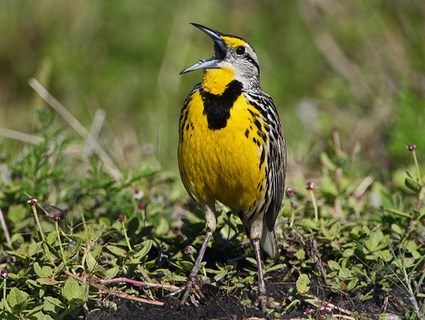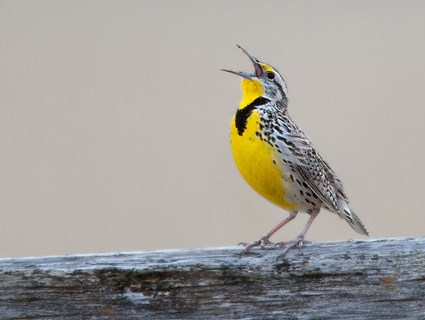This might sound weird, but it is the question I asked my coworker Andrew as we walked past the grassy area by the Visual Arts Building on our way to the orange parking lot one day. I thought for sure the bright yellow object I spotted amongst the earth colored grasses and bushes must be one of those flags that are used to mark the ground when doing construction or digging.
 | |
| See, don't they look just like birds? |
Then all of a sudden the yellow thing moved its wings and I knew it was a bird. I wasn't sure what kind so I threw down my bag so I could get out my binoculars (yes, I ALWAYS carry my binoculars with me) while Andrew kept an eye on the bird so it didn't get away before I could identify it. Luckily the bird didn't fly far and I was able to get a great view of the pretty little guy.
 |
| This is what he looked like. (c) Gerrit Vyn |
After getting a good look at the bird and taking a mental note of its features (longish beak, pinkish legs, black "V" on throat, yellow neck and belly, etc.) I was later able to identify it as an Eastern Meadowlark.
Lucky for me, the bird had been singing or I would not have been able to distinguish him from the very similar Western Meadowlark. These two birds are almost identical and unless you hear them sing it can be impossible to tell them apart--especially when you live in the Midwest and either bird could potentially be visiting. |
| Eastern Meadowlark © CleberBirds, |
 |
| Western Meadowlark (c) Jana Thompson |
Even if you don't find this scientific naming stuff interesting, you can probably agree that this bird is pretty neat looking. I know that I was very pleased to discover this bird since I had never seen one before. Also, I can now add this bird to the list of species that attend our community college!
 |
Beautiful wing display.(c) Jim Chagare |
Speaking of breeding, Eastern Meadowlarks build their nests on the ground in the grasslands and fields. Their nests are made of grass, pine needles, plant stems and even horse hair. It is dome-shaped with a side entrance and both parents take turns incubating their 3-7 eggs.
I really hope the meadowlarks have a successful breeding season this Spring because I would love to see more on campus in the future. Once you see their vibrant color and hear them sing you will surely understand.
 |
| Copyright © 2009 JungleWalk.com |
I end this blog today with a piece of artwork from Charley Harper, one of my favorite artists. He is known for his bird art where he used 'Minimal Realism' to depict wildlife. (www.charleyharperprints.com) Here is his version of a nesting Eastern Meadowlark:
 | |
| Charley Harper "Eastern Meadowlark" |